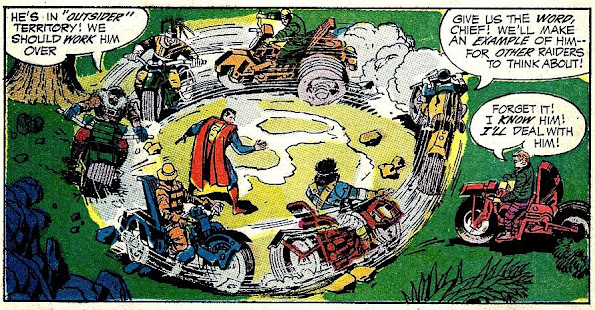"I feel my characters are valid, my characters are people, my characters have hope. Hope is the thing that'll take us through."
I often forget to think of the political and social context of the late-1960s and early-1970s when reading Jack Kirby’s Fourth World comics. Sure there are obvious nods to and caricatures of both comics people and politicians of the day in his work, but the comics are also full of the dread and optimism of the day. Kirby was creating during the Vietnam War and the political conflagration of the anti-War movement, the Civil Rights movement, Second-wave feminism, assassinations, the Boomer youth culture, the Cold War and the Space Race. Today is the 50th anniversary of the Tate-LaBianca murders and it struck me recently while looking into where Kirby actually lived that he arrived in California right in the middle of all the Manson craziness.
The story of Kirby’s first house in California has often been told: How the Kirbys built their dream house only to be forced to move by the noise created by the kids on motorcycles driving around in the valley underneath Jack’s studio, and how those same bikers later found there way into Jimmy Olsen as “The Outsiders”. The Kirby family moved from their dream house into another property in Thousand Oaks and that is the house that most people talk about visiting for the next 20 years or so, until Jack’s death in 1994. (Thanks to Mark Evanier we also now know that Kirby’s first house (the “dream house”) on Lynn Road was just down the road from MGM’s Jungleland theme park, and that the Kirby’s drove by it all the time (possibly an inspiration for “The Zoomway” and the “Wild Area” in Jimmy Olsen).)
In reference to Jack’s “open door” policy towards fans who dropped in on his final Sapra Street home studio unannounced, Linda Kirby is often quoted as saying “if Charles Manson came calling, Jack would let him in.” This got me thinking of the milieu Kirby found himself shortly after moving to the Los Angeles area in the late-60s. Shortly after arriving, the Manson murders gripped the city and the nation. Contemporary accounts of the arrest of Manson and his followers in 1969 describe “a band of nude and long-haired thieves who ranged over Death Valley in stolen dune buggies” --more Hairies and Outsiders inspiration, I’m sure. However, one of the great strengths of Kirby’s work during this period is the optimism he invests in the young “hippie” characters he creates (think Forever People et al) at the same time as some of his work explore the darker underbelly of the Summer of Love and the end of the Sixties. Manson finds his way into many of the sadistic and charismatic characters of the New Gods saga, Darkseid and his cultish minions like Glorious Godfrey, Desaad, Wonderful Willik, and many others, but these are always countered by the good natured heroes of New Genesis, many characters based on younger people Kirby met and worked with, including his own children.




No comments:
Post a Comment